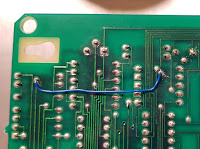Since my 6627A quad power supply is working again, I finally decided to make something long overdue. A breakout box to be able to simply connect to supply to whatever I'm doing on my bench. This is not a complicated design, I had all the components lying around.
The basic function is very simple. The 6627A does not have front connectors, it is designed to be a system power supply sitting in a rack with other equipment. The box connects the rear panel terminal strip to binding posts in an organized manner, so that the supply can be left on the shelf, without the need to access its rear.
I had a buch of HP-like binding posts and also an unused good quality plastic box. I arranged the binding posts on the box in 2 rows of 2 four wire connectors. I used the four wire to be able to compensate for the voltage drop on the connecting cable by also having the sense terminals on the box.
For the wiring, I used two four wire cable for the 4 channels' voltage outputs and one cable with 4 twisted pair lines for the sense lines. The sense lines can be much less in cross section, as they do not carry high current, but they are recommended to be twisted pair for noise suppression.
The whole project took a couple of hours. I drilled the box for the binding posts and connected the wires with spade terminals at the end. Unfortunately the box is a bit small, more space between the channels would have been nice for access, but not a big deal.
The posts for each channel are the standard 19mm apart, so two or four prong connectors could be used.
Basically that is it. I can now put the box on the bench and have the power supply available there. Obviously, the voltage and the sense terminals have to be connected. They will likely be shorted at the box most of the time, but if required this connection can be made elsewhere.
I still need to put labels on the box to identify the channels. It is really bad if you accidentally mix up power supply channels.









